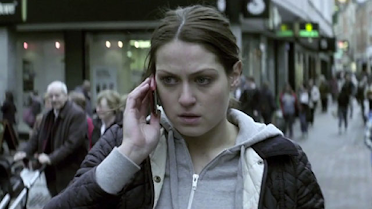Over (2015)
 |
| A still from 'Over' |
Over (dir. by John Threlfall) is a short following the true story of a man who fell to his death from an airplane as it made its approach into Heathrow Airport. He had flown 4000 miles from Angola, hidden in the aircraft's wheel-well before falling to his death and landing in a quiet neighbourhood, his body nearly frozen, after the landing gear was lowered. It is a very intriguing film, as its told in reverse chronology primarily using nine wide shots throughout the film. This methodical and minimalist style is perfect for the film, as it doesn't distract from and allows us to really take our time soaking in the slow unravelling of what happened, and the final shot being the man falling from the air makes the ending so much more potent; leaving us to deal with the implications of this tragic story.
Cinematography in this film is key. As I alluded to before, the bulk of the storytelling comes from only 9 wide shots. These are very methodically set up, and characters can often be seen moving in and out of the frame, while the shot itself stays perfectly static. For example, there is a wide shot that begins with a car being towed away. This car leaves the frame, and a man and a child enter from the opposite side. This is very methodically unveiling the story, and leaving us with a sense of mystery, trying to piece together what is going on. Many shots have moment of prolonged stillness, with nothing at all particularly happening. This slows the pace of the movie down and allows us to ponder on what is happening and really take our time trying to understand the story.
Mise-en-scene plays an important role in this story. It's often used to give us a hint of what might have happened; for example the bouquet of flowers and note left on the kerb suggesting some sort of accident has occurred. Wide shots are often intercut with mid shots of the victims possessions, including a photograph of his family and a pair of his shoes. While watching, we are left to wonder what any of this means and who this man actually is. These items also humanise the victim and honestly gave me a real sense of empathy for him and his situation after we discover what happens.
In terms of sound there is almost no dialogue or soundtrack in this film, leaving the emphasis on the foley. This was was entirely realistic, increasing our sense of verisimilitude while watching the film. For me this really works, as it not only makes the world feel real, but the lack of the tense, eerie style of soundtrack we might expect really creates quite a unique atmosphere that's almost peaceful. It suggests that while this man and his family have suffered such a horrific tragedy due to their own situations being dire, we in the safe haven of our middle class homes can just move on and act like it never happened.


Comments
Post a Comment